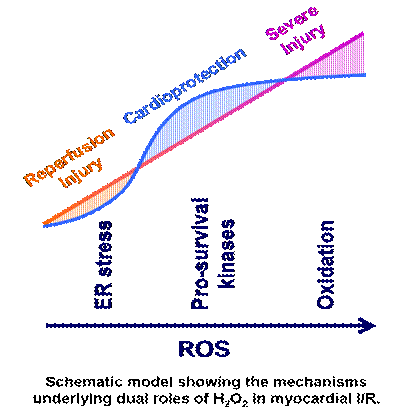6月19日,自然出版集团子刊Cell Death and Disease在线发表了健康科学研究所杨黄恬研究组题为
“Concentration-dependent wrestling between detrimental and
protective effects of H2O2 during myocardial ischemia/reperfusion”
的最新研究成果,揭示了H2O2在心肌缺血复灌(ischemia/reperfusion,
I/R)过程中浓度依赖的损伤与保护的双重作用和不同的作用机制。
心肌梗塞后及时恢复缺血区的血供(再灌注)是挽救缺血心肌的必需步骤,但该过程伴随着严重再灌注损伤的发生。再灌注初期活性氧(reactive
oxygen species,
ROS)的大量释放被认为是造成这一损伤的主要因素之一。然而,ROS也作为启动者介导了缺血预处理(ischemic
preconditioning, IPC)和后处理(ischemic postcondition,
IPoC)等措施对抗心肌I/R损伤的保护作用。为了解释ROS 这种相互矛盾的双重作用,研究者提出了一种假设,即低浓度ROS
作为第二信使参与了心肌保护作用,而高浓度ROS 则导致细胞损伤,但如何界定ROS
起损伤或保护作用浓度界限目前尚无明确的研究,而且该理论无法完美解释众多应用抗氧化剂的临床实验没有显著心肌保护作用的事实。
博士研究生王志华、刘金龙等在杨黄恬研究员的指导下发现H2O2PC和PoC在10-100
mol/L浓度依赖地激活RISK信号通路、抑制其下游的糖原合成酶激酶(glycogen synthase kinase, GSK)3-
活性,进而改善I/R后心功能;而低浓度(1-3 mol/L)及高浓度(1 mmol/Lol/L)
H2O2他则通过不同的机制加重了I/R后心功能不全。低浓度H2O2PC和PoC (1-3 mol/L)
通过进一步上调心肌I/R导致的ER stress加重了I/R后心肌损伤,该效应在3 mol/L
H2O2处理下达到平台期;而高浓度H2O2 (≧100
mol/L)则通过促进氧化应激反应加重I/R后心肌损伤。研究发现证明了浓度是决定ROS不同作用的重要因素之一,揭示了ROS导致心肌I/R损伤和保护作用的浓度阈值和其内在机制,其最终表现是不同浓度ROS启动/激活的损伤与保护通路博弈的结果。研究发现还为解释ROS矛盾作用的机理提供了新的视角,并为开发基于ROS的缺血性心脏病的治疗措施提供了新的实验证据。
此研究得到了国家自然科学基金委和国家科技部973项目的资助。
论文在线发表网址:http://www.nature.com/cddis/journal/v5/n6/full/cddis2014267a.html
Z-H Wang, J-L Liu, L Wu, Z Yu and H-T Yang, Concentration-dependent
wrestling between detrimental and protective effects of H2O2 during
myocardial ischemia/reperfusion. Cell Death and Disease (2014) 5,
e1297
Concentration-dependent wrestling between detrimental and
protective effects of H2O2 during myocardial ischemia/reperfusion
Reperfusion injury after acute myocardial ischemia is a complex
phenomenon that consists of mechanical dysfunction and cell death.
Reactive oxygen species (ROS) and endoplasmic reticulum (ER) stress
are paradoxically implicated in myocardial ischemia/reperfusion
(I/R) injury and cardioprotection. However, the precise
interpretation for the dual role of ROS and its relationship with
the ER stress during I/R remain elusive.
To solve these issues, a team of researchers, led by Dr.
Huangtian Yang, at the Institute of Health Science, investigated
the concentration-dependent effects of hydrogen peroxide (H2O2)
preconditioning (PC) and postconditioning (PoC) on the ER stress
and pro-survival reperfusion injury salvage kinases (RISK)
activation using an ex vivo rat myocardial I/R model. They showed
three phases in the effects of H2O2PC and PoC in myocardial I/R
injury and protection. H2O2PC and PoC at the moderate level
(10-300 mol/L) concentration-dependently improved the
post-ischemic recovery of cardiac performance though the activation
of RISK pathway. In contrast, H2O2 exacerbated I/R-induced
contractile dysfunction via the enhancement of I/R-induced ER
stress at the low level (1 M), and promoted the oxidative
stress at the high level (≧100 mol/L). These findings
demonstrate that the differential effects of H2O2 are derived from
a quantity-dependent wrestling between its detrimental and
signaling roles. This study provides a new angle to interpret the
controversial roles of ROS in myocardial I/R and suggests a hint
for cardiologists to reconsider the clinical translation of
cardioprotective strategies.
This study entitled “Concentration-dependent wrestling between
detrimental and protective effects of H2O2 during myocardial
ischemia/reperfusion” was published online in Cell Death and
Disease on Jun 19, 2014, and was supported by the Major State Basic
Research Development Program of China, National Natural Sciences
Foundation of China, and National Science and Technology Major
Project of China.


